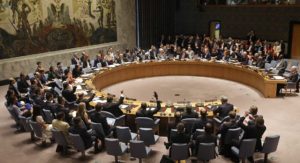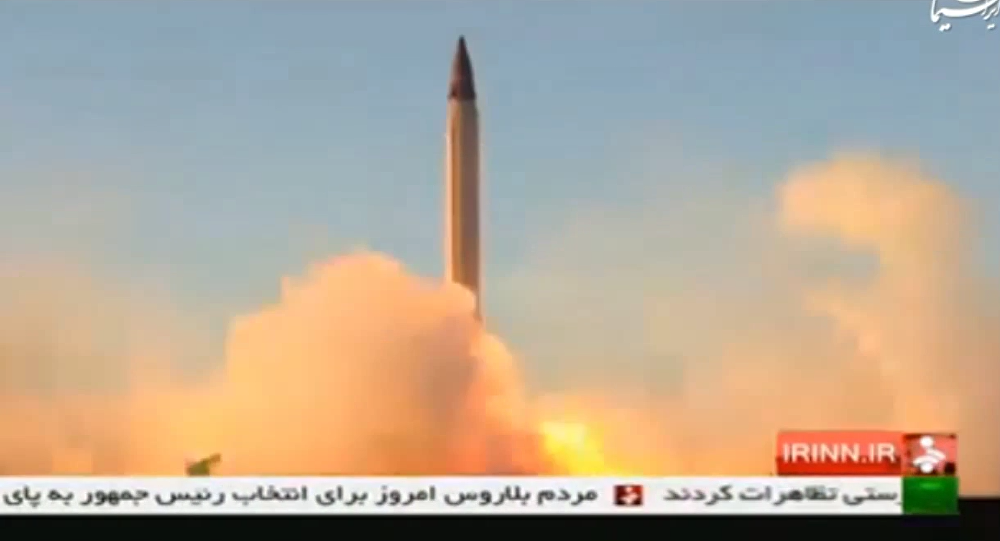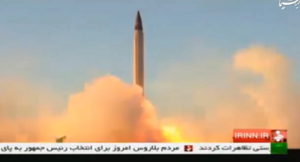On October 10 Iran successfully test launched a new precision-guided ballistic missile. On Wednesday, Britain, France, the United States, and Germany addressed a letter to the United Nations Security Council’s Iran Sanctions Committee claiming that the test violated a Security Council resolution prohibiting Iran from nuclear capable missile testing. In the wake of this allegation, and the recent adoption of the nuclear deal forged between Iran and world powers, there is confusion as to what impact an affirmation of the allegation may have on the deal, and why Iran may have chosen to test now, at such a sensitive time.
The Facts
On July 14 Iran and world powers signed a ground-breaking deal to limit the ‘breakout time’ for Iran to develop a nuclear weapon, in exchange for a reduction and eventual repeal of sanctions levied against the Islamic Republic. For decades, the UN Security Council has held strong to a policy of sanctioning Iran for actions it takes with respect to its nuclear program, a program which Iran has consistently claimed is intended only for peaceful purposes. This deal signals a strong shift by the UN, United States, and world powers in their approach to dealing with Iran, prioritizing direct negotiation and an incentives-based approach over sanctions. The world powers who signed the agreement with Iran include; The United States, France, Germany, China, Russia, and the United Kingdom.
Specific details on the October launch are sparse, but we do know that the missile, named the Emad (Pillar), is a surface-to-surface intermediate-range ballistic missile (IRBM). The missile, precision-guided until it reaches the target, greatly enhances Iran’s medium-range precision strike capabilities because, as reported by Iran’s national news organization, the Emad is “capable of scrutinizing the targets and destroying them completely.” It has been reported that the missile is capable of complete accuracy within a 1,700km range, can carry a 750kg payload, and would be deployed in 2016. The State of Israel, which the leadership of Iran has vowed, but never attempted, to destroy, is within 1,700km range of Iranian territory. Israel and The United States are long-time allies. The tested missile was not loaded with a nuclear weapon, but a ballistic missile is the preferred delivery system for a nuclear warhead.
The letter addressed to the UN stated that the missile was “inherently capable of delivering a nuclear weapon”, and that they hope the information will be used to “examine and take appropriate action in response to violations.”
The Laws
United Nations Security Council Resolution 1929 adopted in June 2010 prohibits Iran from “undertake[ing] any activity related to ballistic missiles capable of delivering nuclear weapons[,]” but the leadership in Iran has consistently, and successfully, rejected the enforceability of UN resolutions targeting its domestic activity.
-

Members of the Security Council vote at United Nations headquarters, Monday, July 20, 2015. The U.N. Security Council unanimously endorsed the landmark nuclear deal between Iran and six world powers and adopted a series of measures leading to the end of U.N. sanctions that have hurt the Iranian economy. (AP Photo/Seth Wenig)
Under the new deal, titled the Joint Comprehensive Plan of Action (JCPOA), world powers have agreed to lift sanctions which were implemented under Resolution 1929, and other resolutions, in exchange for Iran stepping themselves back from developing warhead capability. As a part of the JCPOA a timeline of stages has been set, the first, which began this week, includes a reduction of some sanctions and the beginning of monitoring by the International Atomic Energy Agency (IAEA). UN Security Council Resolution 2231, the implementing document for the JCPOA in the United Nations, mandates that the next stage will begin on the ‘Transition Day’, eight years from Sunday. Annex V, Schedule D para. 19 conditions repeal of sanctions relating to the the international transfer of ballistic weapons to Iran on the completion of IAEA testing and the first phase of the agreement, or on the Transition Day, whichever comes first.
Additionally, while obfuscated by confounding language, the document does lay out a requirement similar to the language in Resolution 1929 prohibiting the development of nuclear ballistic missiles. Paragraph 3 of Annex B states that until the Transition Day, “Iran is called upon not to undertake any activity related to ballistic missiles designed to be capable of delivering nuclear weapons.” The scope of Annex B of Resolution 2231, titled “Statements”, is comprised of additional provisions set forth by each of the signatory world powers which must be met to in order to facilitate complete “implementation of the JCPOA.” Paragraph 3 does allow for an earlier reduction in ballistic weapon sanctions, contingent on an IAEA report that suggests Iran has fully complied with the nuclear capability reduction requirements of the JCPOA prior to the deadline, but the United States has a veto on any proposed early repeal. It should be noted that nothing in the JCPOA or Resolution 2231 explicitly dictates what actions taken by Iran prior to the date of Adoption would violate the agreement, or what force a new violation of Resolution 1929 would have on the implementation of the JCPOA during the 90 days between execution and Adoption.
Analysis
First, referenced above, the launch occurred on October 10, after the execution of the JCPOA but prior to the Adoption Day of Resolution 2231 in the UN. Therefore, it may be argued that the JCPOA and 2231 do not apply. This leads to an interesting analysis, because the penalty for violation of a provision in Resolution 1929 would be economic sanctions, which Iran has consistently ignored and which 2231 is designed to reduce in exchange for cooperation from Iran regarding all facets of their nuclear agreement, which includes nuclear ballistic missile development. It seems, from this perspective, that Iran may have been attempting to get in “one last shot” before the JCPOA is implemented. It had no direct incentive not to do so and knew that the international community would have little recourse in the way of remedy or penalty.
On the other hand, when Iran launched they were fully aware of the imminence of the adoption of the agreement they had signed, and therefore their actions may also be judged by whether they comply with the JCPOA. The preamble to the JCPOA states that the parties to the agreement “commit to implement this JCPOA in good faith and in a constructive atmosphere, based on mutual respect, and to refrain from any action inconsistent with the letter, spirit and intent of this JCPOA that would undermine its successful implementation.” It does not seem that a test launch weeks before Adoption would be in the ‘letter, spirit and intent’ of the deal. The launch did, however, occur just days before Ayatolla Khomeini’s official acceptance on the part of the Islamic Republic, possibly timed as to preempt any consequence under the JCPOA.
Second, there is an important difference in the language of the two resolutions prohibiting Iran from developing nuclear capable ballistic missiles. Resolution 1929 requires that Iran refrain from any activity related to ballistic missiles “capable of delivering [nukes]”, while 2231 prohibits any activity related to ballistic missiles “designed to be capable of delivering [nukes.]” Interestingly enough, when asked to comment, Iranian Foreign Minister Mohammad Javad Zarif said that “none of [Iran’s] missiles has been designed for a nuclear capability”, echoing the less restrictive language of 2231. The argument purported by the US and EU powers in the letter to the Iran Committee said that the missile was “inherently capable” of delivering nukes, focusing on the language of 1929.
Therefore, it seems that the United States claims that all ballistic missiles, whether ‘designed’ for nuclear capability or not, are “capable” of carrying a nuclear weapon, and therefore must fall under the provision as stated in 1929. Does this mean that the US claims that because the launch occurred prior to the Adoption Day of the JCPOA, Resolution 1929, which does not require ‘direction’ and therefore has a lower burden of proof, should be the controlling law? It is unclear whether the administration noticed the difference in the language when adopting their statement, or whether it thought the public would notice. Even if 1929 is the controlling law, the enforcement mechanisms in 1929 were not only ineffective when they were drafted, but are especially ineffective now, since they are in the process of being removed as a part of the JCPOA.
The Iranians, on the other hand, argue that they never conducted activity on missiles ‘designed’ to be nuclear capable, and therefore are not in violation of the provision, even though the test occurred prior to the Adoption Day. The official Iranian statement on the launch echoes the language in the JCPOA, and not that of 1929. The Iranian government has made no comment on whether, since they prefer to define the terms of their actions based on the JCPOA, they consider the launch to be within the ‘letter, spirit and intent’ of deal, as required by the preamble of the agreement. To sum it up, the US prefers the language of the old Security Council resolution, which is more inclusive but has no enforceability, whereas the Iranians defend their actions using the language of the JCPOA, which should be found not to include tests like the one on Oct 10, but if it was, would truly destroy the progress made to reach this deal.
Why Now?
Based on the above analysis, it seems that neither the United States nor the Iranians want this launch, or any subsequent investigation, to detonate the landmark deal. Even so, neither is backing down. White House spokesperson Josh Earnest stated that while the administration was investigating the launch, that the test was “separate from the JCPOA” and did not violate the agreement. While no credible analysts believe that Iran’s ballistic missile program is for peaceful means, non-nuclear capable missile development is not prohibited by the JCPOA. So whether this missile is found to be nuclear capable or not, it has the potential to destabilize, but not detonate, the nascent trust between Iran and world powers. It is a wonder why, then, when the Ayatollah has come out in support of the deal, would he make such a bold, instigating, and seemingly benefit-less choice to launch?
In his effortless brilliance, Thomas Friedman, economist and columnist for the New York Times, may have inadvertently provided the answer almost a month before the launch. In his NY Times column dated September 16, ‘Iran Deal Players’ Report Cards’, Friedman grades all of the actors in the deal and gives the Ayatollah an “A”. He explains that throughout the process, the Supreme Leader had been clever, acting to make himself domestically popular by “cheating” Iran’s way out of the “crippling sanctions, which his people want,” while all the while “giving his hard-line base the feeling that he’s still actually against this deal and his negotiators the feeling that he’s for it.”
While Friedman does end with a humorous reference to lessons the Ayatollah will learn in relation to the imminent domestic democratic transition in Iran, a-la Mikhail Gorbachev, he does also make a poignant parallel to the launch. He reminds us that just a week before the September 17 deadline for the US Senate to block American acceptance of the resolution, the Ayatollah made an ill-timed public statement predicting that Israel “won’t be around in 25 years[.]” This statement was clearly referencing a period of time within which Iran could successfully overcome the effects of the international sanctions and restrictions on its nuclear program by the JCPOA, and develop an actionable nuclear weapon. The statement eruditely left Iran’s direct participation in the destruction of the State of Israel to inference, but was timed specifically to instigate the right-wing in the US Senate and the Israeli government. A simple analogy is made from the statement to the launch of the missile, timed just a week before the Adoption of the JCPOA.
In the end, it is clear that none of the European powers, the US, UN, or Iran want to allow this launch, even if found to be of a missile ‘designed to be nuclear capable’, to destroy the hard-fought nuclear deal. Was the Ayatollah intentionally attempting to derail the agreement? Could he have just been catering to his conservative base by showing that any concessions he makes to support the deal will be in protest? Did he launch to send a little reminder to Israel before allowing his nuclear program to lay dormant?
Clearly, the future of peace and security in the region is too important to risk over a single missile launch. Only time will tell if any lasting effect will result from launch. It is unlikely that any action will be taken by the Security Council to reprimand Iran for launching, because this could cause a rift in the already tenuous partnership. As to the Ayatollah’s intentions? This author hopes that the launch was mere Putin-esq political puffery, destined to be relegated to the history books as the defining record of the most deadly weapon that Iran ever developed, never to be exceeded.
Jeremy S Goldstein is a 3L at the University of Denver – Sturm College of Law and the Online Editor-in-Chief of the Denver Journal of International Law and Policy.




